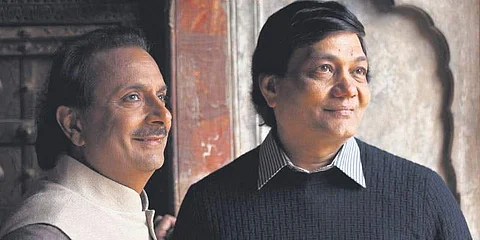

The sheer smithery in gold and silver breathes awe in the unending stretch of ancient accessories arranged across the spanking new Amrapali Museum in Jaipur that unveiled its treasure trove a fortnight ago. A carefully conceived labour of love by Rajiv Arora and Rajesh Ajmera, the creative hearts powering the Amrapali jewellery brand, the museum celebrates Indian craftsmanship at its very best.
For over 40 years, the two men, with a seasoned eye for recognising true worth in jewellery artistry, have been scouring the length and breadth of the country to sift, sieve and ferret out traditional jewellery and artefacts, and to save precious heirlooms from being hammered out into bullion or being reshaped into modern contours.
“We want to preserve the age-old artistry that has formed the soul of India, and share it with students, scholars, researchers, lovers of history, travellers,” say Arora and Ajmera. The duo began their jewelled journey back in 1982 when they chanced on precious craftsmanship in sacks of jewellery being pawned, or sold, by villagers in Calicut. “The thought of losing such brilliant creations to the crucibles, for reshaping, was painful. So we begun our journey of curating a collection of India’s unseen, unsung heritage.” Thus began their collection of exemplary jewellery, knitted by their combined passion for decorative arts.
T

he visual rhythmn unfolds rather lyrically through 4,000 unique collectibles arranged across 6,500 sq ft. Silver allures in its texture, form and function: the antique silver heads of the palanquin dating back to the 19th century, the intricately trellised kalamdan or pen container with a finely detailed sand container for blotting the ink, delicate itrdaans (fragrance dispensers) with multiple mini diya holders, gleaming gunpowder flasks, the traditional Rajasthani head ornament, borla; enamel-laced chunky anklets, minutely crafted hairpins, mathapattis (head ornaments), kaanphools (ear rings), hastphools (hand jewellery), pair phools (foot jewellery), araipatta (waistband), bichwa (toe rings), naths (nose rings), kadas (bracelets)....
“We keep combing the interiors of India for literally unearthing the celebrated handiwork of the yesteryear artisans,” says Arora. “Silver (chandi) is linked to chand (moon) and has a cooling effect on the body, explaining why the bewitching tribal jewellery from north, west and east India is mainly in this metal. Gold (sona) is associated with the warmth of the sun and therefore reigns down south,” he explains, gesturing to the prized tapestry of ornaments in the ‘gold room’ of the museum.
Soldered and chiselled haslis (chokers) with ornamental clasps from Karnataka, an invaluable bajuband from Hyderabad, studded with rose cut diamonds; breathtaking jadai nagam (hair ornaments) wrought in with rubies, emeralds, white sapphires from Tamil Nadu and a gleaming Parsi necklace laced with diamond inlay and words from Avestan credo of the Zoroastrians bewitch here.
“The ‘floating display’ of the artefacts ensures that no hooks are visible, the focus of the spotlight is the artefact,” says Ajmera. The muted grey fabric melts into the background to play up the glory of the craftsmanship of each piece in the carefully curated collection. There is a clever placement of magnifying glasses to treat the visitors to the fine artistry at the back of some of the pieces. “Like the gold bajuband has ‘Ram leela’ depicted in front and ‘Krishna leela’ at the back,” he points out.

“The fine minakari at the back of this gold bajuband would be hidden from your eye, just like the ruby hastphool at the back of the tiny hand at the end of the silver back-scratcher, with concealed daggers within at each end—probably a queen’s vanity essential. Or the meticulously carved scales at the back of the fish-shaped kohl container,” explains Arora.
A level below, in the basement, the trio sets the mood for religious artefacts: in the magnificent gold leaf-laced palna for Lord Krishna, complete with tiny figurines; the beatific, gigantic ashtdhatu statue of Lord Vishnu, hemmed by his dashavatars (10 incarnations) and the flabbergasting silver clothes and ornaments ready to be fitted on to a seated statue of Lord Mahavir, again bordered by the splendid renditions of the 16 dreams that his mother Trishala saw.
Gem-encrusted paandaans, a tiger claw necklace, a fossilised shaligram making up a delicate silver belt, a handpainted shrine accentuated with Basra pearls, gold jooties studded with precious stones, silver mojris and khadau; silver chaupads (game of dice), miniature furniture and kamandalams (holy water containers carried by sages), the finest mango renditions from across the country to paan gillori carriers simply dazzle. A quaint bird duo masquerades as a kettle and creamer set in gold and silver, with mini ivory clutches for insulation.
From Portuguese-styled filigiree and golden thewa of Pratapgarh to the colonial silver from Kutch and ateliers of Awadh, the grandoise of Hyderabad courts to the treasured swatches of splendid Indian bolts of silks and zaris, the unusual mutton fat jade holy bookrest, the silver chuski (wine flask) in the form of a courtesan... the space is a pure treat for fine art aficionados. Then there is the gold and silver celebrated in fabrics through the treasured kalamkari artistry, with heirloom stretches across the walls.
Detailed 3D, backlit photographs of aspects of the carvings on the jewellery add to the rivetting visual mosaic. “The idea is to keep changing the display so that there is something new for you to see each time you visit,” says Arora.